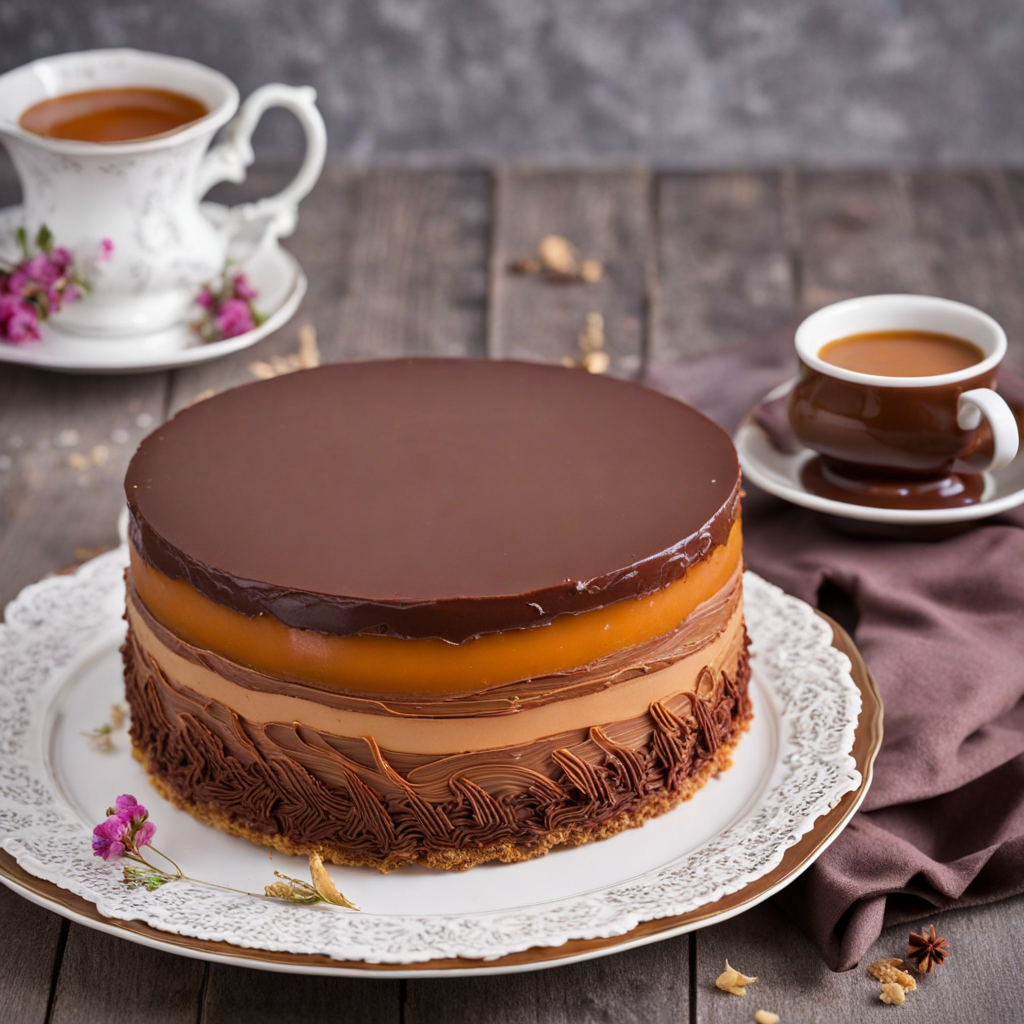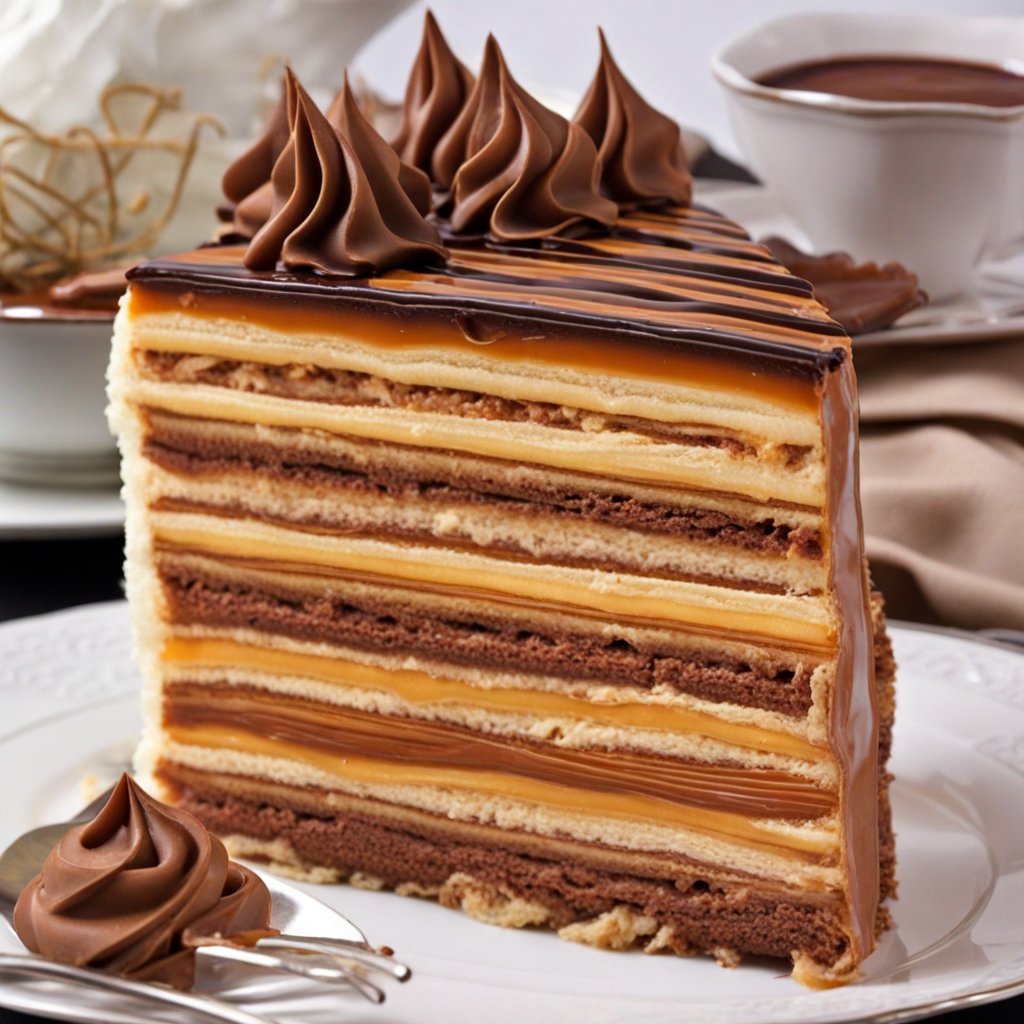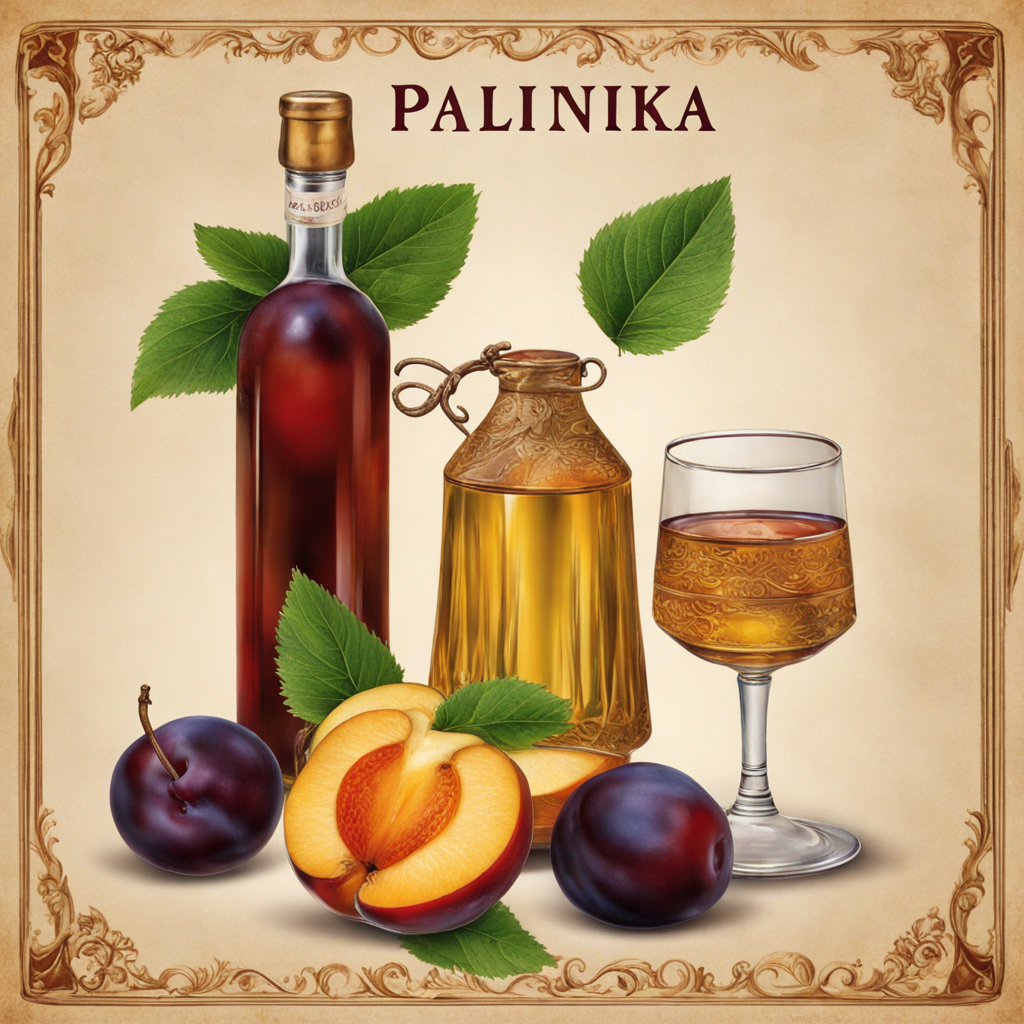Dobos Torte
Dobos Torte is a stunning Hungarian dessert that showcases the country's rich culinary heritage. This multi-layered cake consists of thin sponge layers, typically made from a combination of flour, eggs, sugar, and butter. The cake is known for its delicate texture, achieved through a meticulous baking process that results in soft, airy layers. Each sponge layer is alternated with a luscious chocolate buttercream, which adds a deep, rich flavor that perfectly complements the lightness of the cake. The combination creates a harmonious balance that is both indulgent and satisfying. The crowning glory of Dobos Torte is its signature caramel topping, which not only adds a delightful sweetness but also a beautiful glossy finish. This caramel is skillfully prepared and poured over the top layer of the cake, then scored into triangles for easy serving. The contrast of the crispy caramel with the soft layers beneath adds an exciting texture and visual appeal, making it a showstopper at any gathering. The cake is typically cut into wedges, allowing for a perfect portion to savor its complexity of flavors. As you take your first bite of Dobos Torte, you'll experience a delightful interplay of textures and tastes. The rich chocolate and creamy buttercream meld beautifully with the lightness of the sponge, while the caramel topping provides a satisfying crunch. Each layer offers a unique experience, inviting you to savor the moment. This remarkable dessert is not just a treat for the palate but also a feast for the eyes, making it a beloved classic in Hungarian confectionery that celebrates both tradition and artistry.
How It Became This Dish
The History of Dobos Torta: A Hungarian Culinary Masterpiece Origin: The Birth of Dobos Torta Dobos torta, a rich layered cake adorned with a glossy caramel topping, is one of Hungary's most celebrated culinary creations. Its origins trace back to the late 19th century, during a period when Budapest was emerging as a cultural and culinary hub in Europe. The cake was named after its creator, József Dobos, a renowned Hungarian pastry chef who introduced it to the world in 1884. Dobos was not only a talented baker but also an innovator in the culinary arts. He sought to create a cake that could withstand the rigors of travel, preserving its flavor and texture. At that time, Hungary was undergoing a gastronomic renaissance, influenced by its rich traditions and the culinary trends sweeping across Europe. The Dobos torta was a perfect marriage of rich flavors and practical design, featuring layers of sponge cake interspersed with chocolate buttercream and crowned with a striking caramel glaze. Cultural Significance: A Symbol of Hungarian Heritage The Dobos torta is more than just a dessert; it holds a special place in Hungarian culture and history. The cake quickly became a staple at celebrations, weddings, and festive occasions, embodying the Hungarian spirit of hospitality and indulgence. Its intricate layers and luxurious taste made it a favorite among the upper classes, but it eventually transcended social boundaries, becoming beloved by people from all walks of life. In Hungary, baking was and still is often seen as a communal activity, a way to gather family and friends. The Dobos torta, with its complex preparation and impressive presentation, has been passed down through generations, each household adding its own twist to the traditional recipe. The cake has become a symbol of pride for many Hungarian families, a way to connect with their roots and celebrate their culinary heritage. In 1885, the Dobos torta garnered international acclaim when it was presented at the National General Exhibition in Budapest, where it won the prestigious Grand Prize. This recognition not only solidified its place in Hungarian gastronomy but also showcased the artistry and skill of Hungarian pastry chefs to the world. Development Over Time: An Evolution of Taste The late 19th and early 20th centuries marked a significant period in culinary history, with the rise of patisserie as an art form. The Dobos torta exemplified this evolution, showcasing the intricate techniques and high-quality ingredients that defined the era. The original recipe crafted by József Dobos used a combination of eggs, sugar, flour, and butter for the sponge cake, while the buttercream was made with dark chocolate, creating a rich and decadent flavor profile. As the years progressed, the cake underwent various adaptations. During the interwar period, the influence of modern baking techniques and the availability of new ingredients led to variations of the classic Dobos torta. Chefs began experimenting with different types of chocolate, adding flavorings like vanilla or coffee, and incorporating fruits or nuts into the layers. These innovations not only enhanced the cake’s flavor but also made it more accessible to a broader audience. The aftermath of World War II brought challenges to Hungary's culinary landscape, including scarcity of ingredients and economic hardship. However, the Dobos torta remained a cherished dessert, often made for special occasions and holidays. In the 1950s and 1960s, as Hungary began to stabilize, the cake saw a resurgence in popularity. It became a symbol of resilience and celebration, representing the enduring spirit of the Hungarian people. In the late 20th century and into the 21st century, the globalization of food culture began to influence traditional recipes. The Dobos torta, while still revered in Hungary, found its way into international pastry shops and bakeries. Chefs around the world embraced the cake, offering their own interpretations while maintaining the essence of Dobos's original creation. This fusion of cultures has led to unique variations, including the incorporation of modern techniques such as molecular gastronomy and new flavor profiles that appeal to contemporary palates. Modern Day: A Global Icon Today, Dobos torta is celebrated not only in Hungary but also around the globe. It is often featured in Hungarian restaurants and pastry shops, where it is served alongside a cup of strong coffee or tea. The cake has also become a popular choice for food enthusiasts and home bakers, who are eager to replicate its beauty and complexity in their own kitchens. Culinary competitions and festivals often highlight the Dobos torta, showcasing its place in both traditional and modern Hungarian cuisine. The cake's stunning appearance, with its multiple layers and gleaming caramel top, continues to captivate audiences at culinary events, where it is often presented as a labor of love and skill. Dobos torta has also found a place in the hearts of those who seek to understand the cultural significance of food. It represents a bridge between the past and present, demonstrating how culinary traditions can evolve while still maintaining their core essence. In this way, the cake serves not only as a delectable dessert but also as a vessel for storytelling, connecting individuals to their heritage and to each other. Conclusion: The Legacy of Dobos Torta In conclusion, the story of Dobos torta is one of innovation, tradition, and cultural significance. From its humble beginnings as a travel-friendly cake to its status as a symbol of Hungarian culinary pride, Dobos torta has woven itself into the fabric of Hungary's gastronomic identity. It reflects the resilience of the Hungarian people and their ability to adapt while honoring their rich history. As we enjoy a slice of Dobos torta today, we partake in a piece of history that transcends time and borders. Whether savored in Budapest's charming cafés or recreated in kitchens far and wide, this magnificent cake continues to delight and inspire, ensuring that the legacy of József Dobos and his exquisite creation will endure for generations to come.
You may like
Discover local flavors from Hungary







